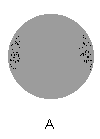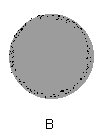< Page 14 of 15 >
1 2 3 4 5 6 7 8 9 10 11 12 13 14 15
Staining Patterns
Limbal
Peripheral Staining and Punctate Staining Induced by Defective Tear
Film Distribution
Defective tear film distribution can be due either to abnormalities
in the quantity or composition of the tear film, or by blinking problems
such as a decreased blink rate or �false� blinking, or by a tight fitting
rigid lens which inhibits tear circulation Such conditions can lead
to corneal exposure and drying, or to corneal hypoxia under the contact
lens, or both.
-
Desiccation or drying of the corneal epithelium around the periphery of the lens, especially at the 3 and 9 o�clock. Movement of the lens over these areas can dislodge the compromised epithelial cells.
-
Hypoxia, (oxygen deprivation) under the lens due to inadequate tear flow can lead to the development of microcysts. When these rupture or are abraded, defects will result.
- Corneal edema resulting from chronic hypoxia can alter the corneal contour and thereby reduce the normal clearance between the cornea and the posterior lens surface. Epithelial defects can then result from the lens movement over these areas.
 |
 |
Figure A above illustrates limbal peripheral staining at 3 and 9 o'clock.
Figure
B above shows a 360 degree peripheral stain. It may possibly be caused
by a small diameter soft lens, a lens edge which is dehydrated or wrinkled,
a damaged lens edge, or dried mucus or other lens deposits.
|
Dry Spots |
|
 |
 |
|
C
|
D
|
Dry spots are illustrated in figure C above. These are areas of the cornea which appear dark rather than stained and retain their configuration during blinks. Possible causes include a poorly lubricated epithelium resulting from a healing abrasion, a recurrent abrasion, or kerititis sicca (dryness of the cornea). Figure D shows epithelial depressions. Air bubbles trapped beneath a lens produce a series of round depressions in the epithelium. Normally there is no break in the epithelium and within minutes of removing the lens, the depressions disappear.
|
|
|
|
|
E
|
A diffuse punctate staining pattern can be caused by toxic epithelial injury. It can be the result of wetting, cleaning, and storage solutions or eye drops. Other possible causes are chlorine (swimmer�s eye) or atmospheric conditions such as toxic pollutants. Figure Eshows a chemical stain where the cornea appears to have a hazy surface due to numerous punctate stains and microcysts which cover the entire cornea to the limbus.
< Page 14 of 15 >
1 2 3 4 5 6 7 8 9 10 11 12 13 14 15
